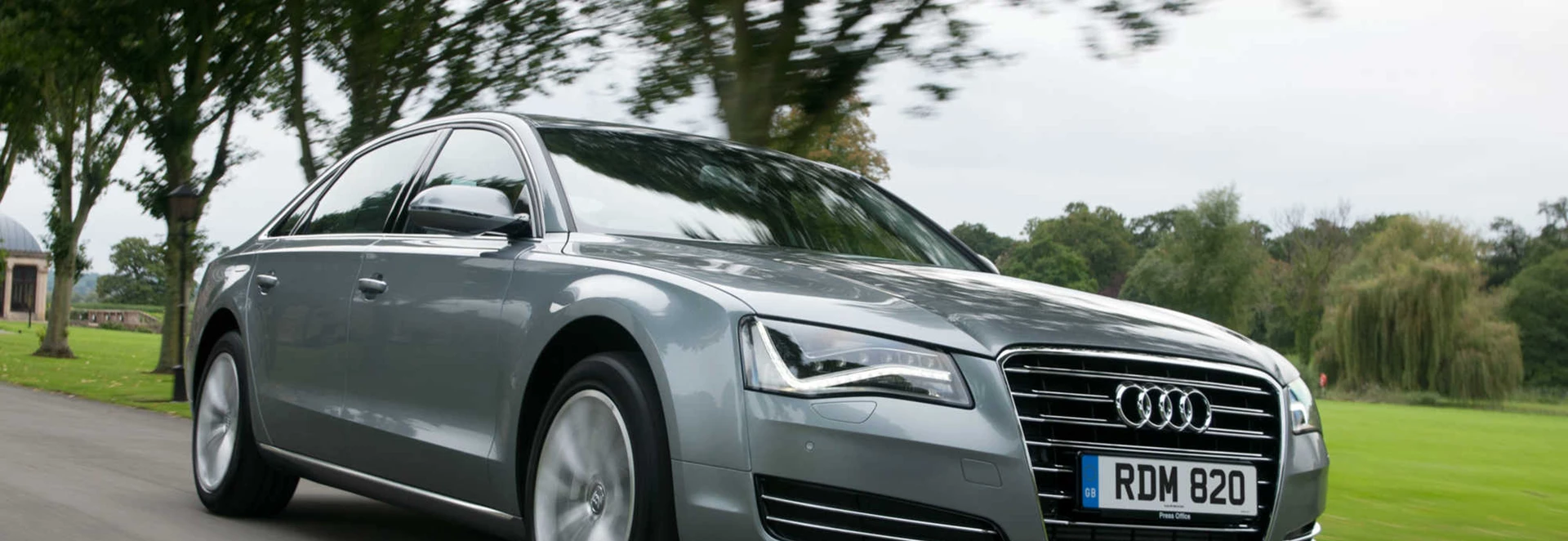A typically understated appearance hides the fact that the A8 is Audi's luxury saloon - a rival to the BMW 7 Series, Jaguar XJ and Mercedes S-Class.
The current-generation A8, last updated in 2013, is lighter than it looks (most versions have a kerb weight of under 2,000kg) because the main body structure is made of aluminium rather than steel.
There are short and long-wheelbase bodies and a choice of various petrol and diesel engines, plus a petrol-electric hybrid which is the only version with front rather than four-wheel drive. The A8 also forms the basis for the S8, which used to have a modified version of the Lamborghini Gallardo's V10 engine but is now fitted with a more powerful twin turbo V8.
Performance
With the exception of the Hybrid, which is the slowest model by some distance, all A8s have a 0-62mph sprint time of 6.1 seconds or less and have an electronically-limited top speed of 155mph.
Maximum power output doesn't closely correlate with acceleration from a standing start, as the 429bhp 4.0 TFSI and 493bhp 6.3 W12 share the honours on 4.6 seconds. The more economical 380bhp 4.2 TDI diesel is only a tenth of a second slower on the same run. Where there's a choice of body styles, long-wheelbase models are 0.2 seconds slower than standard-length ones.
A8 specifications are generally quiet but have good-sounding engines, though the four-cylinder unit in the Hybrid seems rather ordinary in a luxury car. The only available gearbox available for the A8 is a smooth-shifting eight-speed automatic.
Ride and Handling
It actually handles very well, but it's at its best when wafting seamlessly from one bend to another.
The A8 is not a car to be rushed, and if you want to go quickly you'll probably rely more on the acceleration than the cornering ability. It actually handles very well, but it's at its best when wafting seamlessly from one bend to another. The ride quality is excellent, more so when the car has modestly sized wheels as opposed to the larger ones (with lower-profile tyres) which are available as optional extras.
Interior and Equipment
This is the third-generation A8. The first was launched in 1994 as a replacement for the Audi V8.
Versions with a single power source are offered in SE, SE Executive and Sport Executive trim levels. The Hybrid has its own specification, with slightly more equipment than the SE. Standard kit on all of them includes DAB digital radio, leather upholstery, heated front seat, keyless start, cruise control, double-glazed windows and automatic headlights and wipers. All Audi A8s except the SE trim have an automatically opening bootlid. Luggage space is 490 litres in short-wheelbase cars and 520 litres in the longer ones. The boot of the Hybrid is compromised by the need to find somewhere to put the battery pack, and its capacity is therefore 335 litres, or less than that of the A3 hatchback. Passenger room in the back of the long-wheelbase models is of course plentiful. The level of comfort is very high, though like several other Audis the A8's footrest is mounted too far away to be used comfortably.
Cost
None can match the 3.0 TDI's 47.9mpg (or 47.1mpg in long-wheelbase form).
Nearly every A8 costs more than £60,000 to buy, and the range-topping W12 is close to six figures. Despite cylinder-on-demand technology, intended to improve fuel economy, it's also very thirsty, with combined fuel economy of just 25.0mpg. Other petrol-engined versions, and the 4.2 TDI diesel, do considerably better than that, but none can match the 3.0 TDI's 47.9mpg (or 47.1mpg in long-wheelbase form). The Hybrid is both slower and more expensive than the 3.0 TDI, and you might have expected this to be balanced by better fuel economy. Officially, it isn't: combined fuel economy is 45.6mpg (short-wheelbase) or 44.8mpg (long-wheelbase), though real-world figures will depend on driving conditions. In town, the Hybrid will be better. On motorways, the TDI diesel will. The Hybrid does, however, have an advantage in terms of CO2 emission and therefore tax liability. Vehicle Excise Duty costs £15 less per year, and depending on body style the Benefit In Kind rating is up to three percentage points lower.
Our Verdict
Despite Audi's long history of building large saloons there may be a perception in some quarters that this is more BMW and Mercedes territory. That isn't entirely fair. The 7-Series and S-Class are splendid cars, but the A8 is a very strong contender, with a real feeling of quality in its build, appointments and on-road behaviour. A close resemblance to the much cheaper A4 and A6 probably isn't helpful, but if you can get over that the A8 is worth paying close attention to. The 3.0 TDI feels like the most sensible choice, since it's more than fast enough and impressively economical, though we could understand the appeal of being among the very few people to own the W12.




